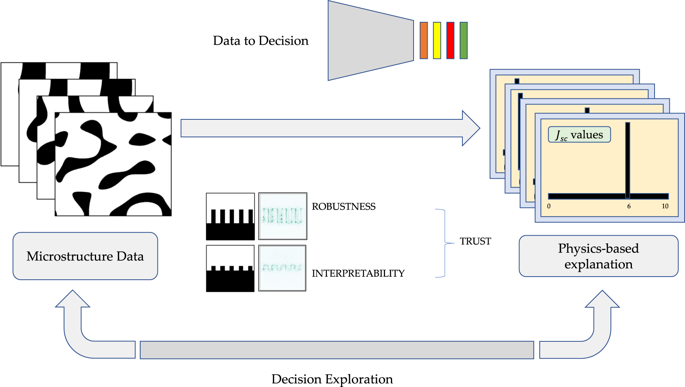npj Computational Materials ( IF 9.4 ) Pub Date : 2019-10-01 , DOI: 10.1038/s41524-019-0231-y Balaji Sesha Sarath Pokuri , Sambuddha Ghosal , Apurva Kokate , Soumik Sarkar , Baskar Ganapathysubramanian

|
The microstructure determines the photovoltaic performance of a thin film organic semiconductor film. The relationship between microstructure and performance is usually highly non-linear and expensive to evaluate, thus making microstructure optimization challenging. Here, we show a data-driven approach for mapping the microstructure to photovoltaic performance using deep convolutional neural networks. We characterize this approach in terms of two critical metrics, its generalizability (has it learnt a reasonable map?), and its intepretability (can it produce meaningful microstructure characteristics that influence its prediction?). A surrogate model that exhibits these two features of generalizability and intepretability is particularly useful for subsequent design exploration. We illustrate this by using the surrogate model for both manual exploration (that verifies known domain insight) as well as automated microstructure optimization. We envision such approaches to be widely applicable to a wide variety of microstructure-sensitive design problems.
中文翻译:

可解释的深度学习,用于光伏中的引导性微结构-特性探索
微观结构决定了薄膜有机半导体膜的光伏性能。微观结构和性能之间的关系通常是高度非线性的,评估起来很昂贵,因此使微观结构优化面临挑战。在这里,我们展示了一种数据驱动的方法,用于使用深度卷积神经网络将微观结构映射到光伏性能。我们用两个关键指标来描述这种方法的特征,即它的可概括性(它是否学到了一个合理的图?)和它的可解释性(它能否产生有意义的微观结构特征来影响其预测?)。展现通用性和可解释性这两个特征的替代模型对于后续的设计探索特别有用。我们通过使用代理模型进行人工探索(验证已知领域的洞察力)以及自动微观结构优化来说明这一点。我们设想这样的方法将广泛适用于各种对微结构敏感的设计问题。











































 京公网安备 11010802027423号
京公网安备 11010802027423号